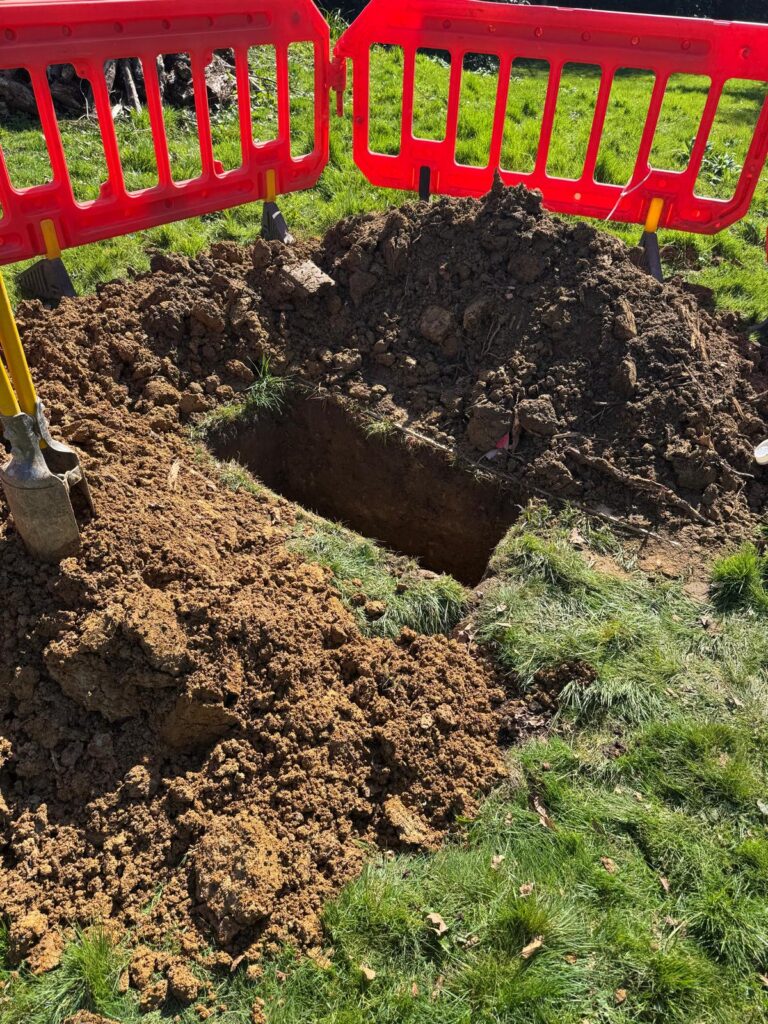Book your soakage test with us for an expert and professional service.

We conduct BRE365 soakaway tests to assess the permeability of the soil and determine the feasibility of infiltration systems for surface water disposal.
We provide BRE365 and percolation soakage tests across the South East region and beyond.
BRE365 Soakage Tests are carried out to determine whether the ground conditions at a development site are suitable for infiltration based drainage solutions, such as soakaways or permeable pavement as part of Sustainable Drainage Systems (SuDS).
Scroll down to understand why you might need a soakage test for your site.
A BRE365 soakage test is a site-based investigation used to measure how quickly water drains into the ground. It’s essential for assessing whether infiltration systems—such as soakaways—can be used effectively on a site. The test follows guidance set out by the Building Research Establishment Digest 365 (BRE365) and is often required to support planning applications where sustainable drainage is proposed.
You might also hear soakage tests referred to as:
Infiltration Testing
Percolation Testing
Permeability Testing
Flow Tests
In the past, people often disposed of surface water by routing it into a rubble-filled pit—known as a soakaway—without understanding how quickly the water would infiltrate the soil, the temporary storage required for the catchment area being drained and any climate change impact. This uncontrolled approach often led to water-logging as the speed of water draining away did not match the storage requirements, and increased flood risk both on-site and downstream.
Today, infiltration remains at the top of the Sustainable Drainage Systems (SuDS) hierarchy. However, best practice and national guidance require that any proposed infiltration method is backed by site-specific testing. For this reason, Local Planning Authorities (LPAs), in consultation with Lead Local Flood Authorities (LLFAs) or Drainage Officers (DOs), will often request a BRE365 soakage test as part of a planning submission.
If this test is not carried out—or is carried out incorrectly—the LLFA or DO may recommend that planning permission be refused due to insufficient evidence on flood risk or surface water management.
It’s not sufficient to simply state that a site naturally soaks away. Local Planning Authorities require evidence-based testing, such as a BRE365 infiltration test, to demonstrate that infiltration is viable and appropriate for the site.
A BRE365 soakage test involves:
1. Digging a trial pit to the proposed infiltration depth
2. Filling the pit with water
3. Gather data accurately to measure how long it takes for the water to soak into the ground.
This process is repeated at least three times to simulate saturated conditions and gather accurate infiltration data. Once the test is complete, we use the data to calculate the infiltration rate using a specific formula outlined in the BRE365 guidance. These calculations must be done precisely, as they directly inform the design of soakaways and other sustainable drainage systems.
It’s a technical process that requires both site expertise and engineering judgement to ensure the results are robust and accurate for planning and design approvals.
As the test informs key engineering decisions, it must be carried out precisely, with experienced site supervision and accurate recording. A reliable soakage test helps ensure your drainage design is compliant, sustainable, and ready for planning approval.



Need a BRE365 Soakage Test for your site?
We offer fast, professional testing across the South East, with clear reporting to support your planning application.
Contact us today to discuss your project or request a quote.
